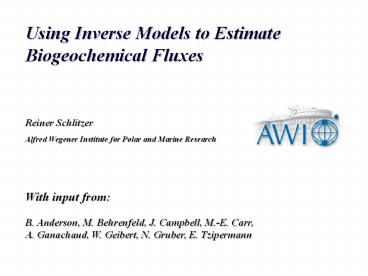PowerPoint-Pr - PowerPoint PPT Presentation
Title:
PowerPoint-Pr
Description:
Reiner Schlitzer. Alfred Wegener Institute for Polar and Marine Research. With input from: B. Anderson, M. Behrenfeld, J. Campbell, M.-E. Carr, ... – PowerPoint PPT presentation
Number of Views:17
Avg rating:3.0/5.0
Title: PowerPoint-Pr
1
Using Inverse Models to Estimate Biogeochemical
Fluxes
With input from B. Anderson, M. Behrenfeld, J.
Campbell, M.-E. Carr, A. Ganachaud, W. Geibert,
N. Gruber, E. Tzipermann
2
Nitrate transports
Ganachaud Wunsch
3
(No Transcript)
4
(No Transcript)
5
(No Transcript)
6
(No Transcript)
7
- Objective
- Use 3D global inverse model
- to determine ...
- circulation
- POC opal export fluxes
- remineralization parameters
- by fitting the model to global
- ocean, high-quality datasets
- of ...
- T, S
- oxygen, dissolved nutrients
- DIC, Alkalinity
- CFC, Radiocarbon
8
(No Transcript)
9
(No Transcript)
10
(No Transcript)
11
(No Transcript)
12
R. Schlitzer
13
R. Schlitzer
14
70 100 Tmol Si yr-1
R. Schlitzer
15
(No Transcript)
16
PRIMARY PRODUCTION ALGORITHM ROUND-ROBIN 3
(PPARR3)
(lt40S)
Carr et al.
17
(No Transcript)
18
(No Transcript)
19
Polarstern ANT X/6 (Oct-Dec 92) BathmannVeth,
unpublished
20
Geibert Usbeck
21
Seawater supply
Max.
Geibert Usbeck
22
Southern Ocean lt50S
Flux in 1000 m 35 smaller as compared to b0.856
case.
Schlitzer, 2002
23
Export Comparison
R. Schlitzer
24
Surface Water
Latitude
25
- Significant POC Export in the Southern Ocean
- (ca 1 Gt C/yr south of 50S out of ca. 9 Gt
C/yr globally) - Previously Underestimated by Satellite PP
Algorithms - (callibration issue sub-surface chlorophyll)
- Zonal Succsession of Opal and Carbon Flux Maxima
- (explained as delicate balance between upward
physical transport - and downward flux by particles differences
in remineralization matter) - C-sequestration due to Iron Fertilization in
Upwelling - Regimes likely to be inefficient
- (exported POC is remineralized shallow and
quickly returned to - surface layer)
26
Thanks to JGOFS WOCE PIs for producing high
quality, global datasets of biogeochemical
variables and circulation tracers !!!






























